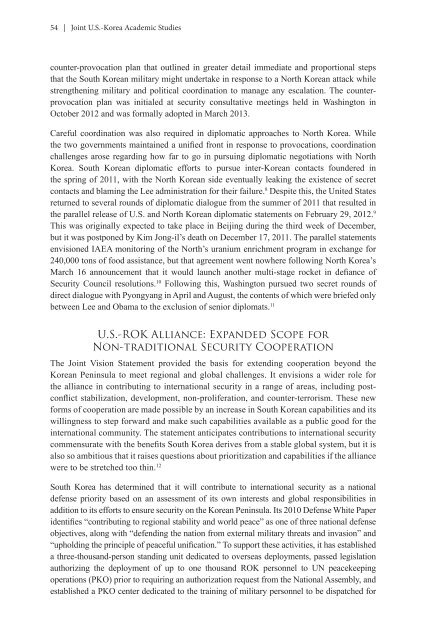the full publication PDF - Korea Economic Institute
the full publication PDF - Korea Economic Institute
the full publication PDF - Korea Economic Institute
Create successful ePaper yourself
Turn your PDF publications into a flip-book with our unique Google optimized e-Paper software.
54 | Joint U.S.-<strong>Korea</strong> Academic Studies<br />
counter-provocation plan that outlined in greater detail immediate and proportional steps<br />
that <strong>the</strong> South <strong>Korea</strong>n military might undertake in response to a North <strong>Korea</strong>n attack while<br />
streng<strong>the</strong>ning military and political coordination to manage any escalation. The counterprovocation<br />
plan was initialed at security consultative meetings held in Washington in<br />
October 2012 and was formally adopted in March 2013.<br />
Careful coordination was also required in diplomatic approaches to North <strong>Korea</strong>. While<br />
<strong>the</strong> two governments maintained a unified front in response to provocations, coordination<br />
challenges arose regarding how far to go in pursuing diplomatic negotiations with North<br />
<strong>Korea</strong>. South <strong>Korea</strong>n diplomatic efforts to pursue inter-<strong>Korea</strong>n contacts foundered in<br />
<strong>the</strong> spring of 2011, with <strong>the</strong> North <strong>Korea</strong>n side eventually leaking <strong>the</strong> existence of secret<br />
contacts and blaming <strong>the</strong> Lee administration for <strong>the</strong>ir failure. 8 Despite this, <strong>the</strong> United States<br />
returned to several rounds of diplomatic dialogue from <strong>the</strong> summer of 2011 that resulted in<br />
<strong>the</strong> parallel release of U.S. and North <strong>Korea</strong>n diplomatic statements on February 29, 2012. 9<br />
This was originally expected to take place in Beijing during <strong>the</strong> third week of December,<br />
but it was postponed by Kim Jong-il’s death on December 17, 2011. The parallel statements<br />
envisioned IAEA monitoring of <strong>the</strong> North’s uranium enrichment program in exchange for<br />
240,000 tons of food assistance, but that agreement went nowhere following North <strong>Korea</strong>’s<br />
March 16 announcement that it would launch ano<strong>the</strong>r multi-stage rocket in defiance of<br />
Security Council resolutions. 10 Following this, Washington pursued two secret rounds of<br />
direct dialogue with Pyongyang in April and August, <strong>the</strong> contents of which were briefed only<br />
between Lee and Obama to <strong>the</strong> exclusion of senior diplomats. 11<br />
U.S.-ROK Alliance: Expanded Scope for<br />
Non-traditional Security Cooperation<br />
The Joint Vision Statement provided <strong>the</strong> basis for extending cooperation beyond <strong>the</strong><br />
<strong>Korea</strong>n Peninsula to meet regional and global challenges. It envisions a wider role for<br />
<strong>the</strong> alliance in contributing to international security in a range of areas, including postconflict<br />
stabilization, development, non-proliferation, and counter-terrorism. These new<br />
forms of cooperation are made possible by an increase in South <strong>Korea</strong>n capabilities and its<br />
willingness to step forward and make such capabilities available as a public good for <strong>the</strong><br />
international community. The statement anticipates contributions to international security<br />
commensurate with <strong>the</strong> benefits South <strong>Korea</strong> derives from a stable global system, but it is<br />
also so ambitious that it raises questions about prioritization and capabilities if <strong>the</strong> alliance<br />
were to be stretched too thin. 12<br />
South <strong>Korea</strong> has determined that it will contribute to international security as a national<br />
defense priority based on an assessment of its own interests and global responsibilities in<br />
addition to its efforts to ensure security on <strong>the</strong> <strong>Korea</strong>n Peninsula. Its 2010 Defense White Paper<br />
identifies “contributing to regional stability and world peace” as one of three national defense<br />
objectives, along with “defending <strong>the</strong> nation from external military threats and invasion” and<br />
“upholding <strong>the</strong> principle of peaceful unification.” To support <strong>the</strong>se activities, it has established<br />
a three-thousand-person standing unit dedicated to overseas deployments, passed legislation<br />
authorizing <strong>the</strong> deployment of up to one thousand ROK personnel to UN peacekeeping<br />
operations (PKO) prior to requiring an authorization request from <strong>the</strong> National Assembly, and<br />
established a PKO center dedicated to <strong>the</strong> training of military personnel to be dispatched for










